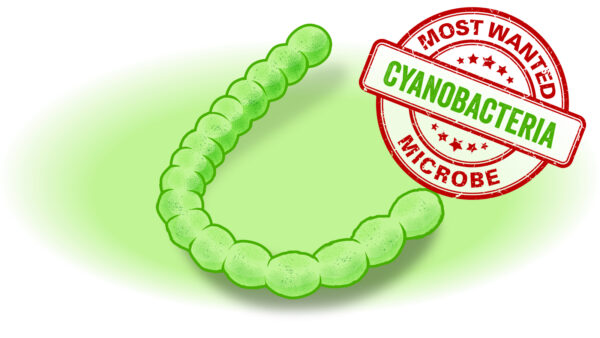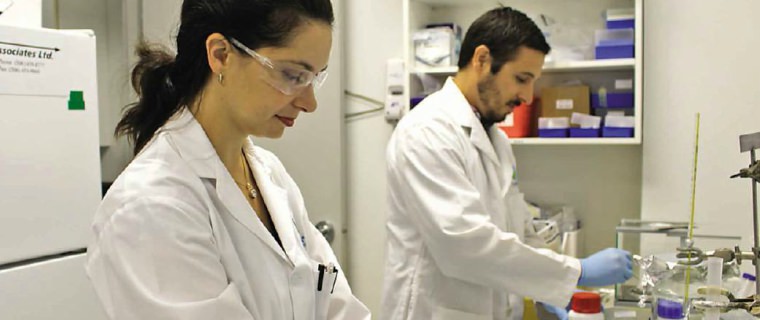An image search for the term “algae” quickly reveals a page filled with photos of green-colored surface water. Many of these green blooms that often invade our lakes and rivers are well known by water treatment professionals and the public as ‘blue-green algae’. It’s responsible for beach closures, public health risks, and creates significant challenges for water treatment utilities.
Blue-green algae, however, is not actually algae but a unique type of bacteria called cyanobacteria. They are classified under the Kingdom Monera (Prokaryota) and Division Eubacteria and while they are gram-negative bacteria, they also have green pigmentation and the ability to photosynthesize, similar to algae cells.
Cyanobacteria are common in most surface waters ranging from ponds and lakes to streams and rivers, and usually only become an issue when human activity leads to an increase in specific nutrients; nitrogen and phosphorous (>25-50 µg/L). The most common genera in surface water include Anabaena, Aphanizomenon, Microcystis, Oscillatoria, and Planktothrix to name a few. Many have gas-filled cavities that allow them to control their depth to optimize light and nutrient levels. Other factors that affect growth include increased water temperature (>25C), pH (>6-7), water flow, water column stability (low/no current), and changes in precipitation.
What are the risks associated with cyanobacteria?
The harmful effects of cyanobacterial blooms include: depleted oxygen levels resulting in plant and animal die-off, taste and odour issues in drinking water (i.e. geosmin), and – under the right conditions – the production of toxic metabolites, known as cyanotoxins. These cyanotoxins, such as Microcystin-LR, can be released into the environment by the active cell or contained within the cytoplasm and cell membrane until the cell dies off and the membrane degrades, releasing the toxins into the surrounding water.
Exposure to cyanotoxins can occur through the ingestion of contaminated drinking water or recreational water and inhalation of aerosols from contaminated source water. Symptoms range from headache and fever, to muscle and joint pain, and ulcers and blisters. In high concentrations, they can also lead to seizures, liver failure, and neurotoxicity.
In July 2016, a blue-green algae outbreak in Utah Lake, a popular 150-square-mile lake, sickened over 100 people, and left many farmers searching for clean water for livestock. With outbreaks becoming more and more common, water treatment professionals are looking for better ways to manage and prevent cyanobacterial blooms.
How can you identify growth in the early stages and reduce their occurrence?
Monitoring and addressing nutrient pollution can proactively keep cyanobacterial populations low and prevent dangerous blooms. The EPA suggests implementing numeric nutrient criteria and cyanotoxin criteria into water quality programs to monitor both nutrient and cyanotoxin levels in source or recreation water. Secchi disc transparency monitoring during typical cyanobacteria season can provide an indicator of risk level and biological assays like protein phosphatase inhibition assays (PPIA) and enzyme-linked immunosorbent assays (ELIZA) can detect certain cyanotoxins. Other methods include gas chromatography with either flame ionization detection (GC/FD) or mass spectrometry (GC/MS), and various forms of liquid chromatography.
If cyanobacteria are present, treatment methods typically involve removing the cells through pre-treatment oxidation, coagulation/sedimentation, membrane filtration, or floatation. For extra-cellular cyanotoxins, UV treatment and/or chemical treatment with potassium permanganate, chlorine, and activated carbon may be applied.
Recently, hydrogen peroxide has demonstrated promising results against golden algae, Prymnesium parvum, after several successful trials in 2017 by the John Innes Centre and their research also found that blue-green algae was even more susceptible. This could be a cheaper, safer, and more effective way to manage cyanobacterial outbreaks.
While there are no legally enforceable federal standards for cyanobacteria and cyanotoxins, the EPA has established Health Advisories (HAs) of 0.3 µL and 0.7 µg/L for microcystins and cylindrospermopsin, respectively, for pre-school children, and 1.6 µg/L and 3 µg/L for school-aged children and adults. Certain U.S. states have also implemented standards and guidelines for cyanotoxins including microcystin, anatoxin-a, cylindrospermopsin, and saxitoxin.
Effectively managing source water contamination, whether it be cyanobacteria blooms or other microbial contaminants, requires a wide variety of tools and approaches. LuminUltra’s 2nd Generation ATP test kits can help utilities improve their water management plans by immediately assessing the total microbial population and providing a first warning sign to water treatment professionals that the microbial population, and risk level, has increased.
Further reading:
Harmful Algal Blooms – What’s in Your Drinking Water Intake?









